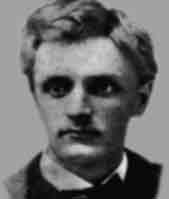Hall of Fame Inductee

George Ligowsky
The target and trap invented by George Ligowsky of Cincinnati are credited with giving modern-day trapshooting its start. Ligowsky invented the original clay target in 1880, and today’s present clays closely resemble his invention.
Following is a synopsis of Ligowsky’s development of the clay pigeon as presented by Bill Doepperman in Outdoor Life some years ago.
Ligowsky invented his clay pigeon as a substitute for a substitute, as it was intended to replace the glass ball, the invention that had been intended to replace live pigeons at the traps. Various substitutes had been tried: glass balls that burst into what looked like smoke when struck, emitted feathers or a flash of light and even one that was made out of what was advertised as a fertilizer; rubber balloons fitted into cardboard discs to resemble the planet Saturn; the gyro bird, which was a propeller-type target; the tin pigeon, shaped somewhat like a conventional clay target with a metal disc attached to it by a small chain (the disc was supposed to disengage from its position in the target when struck and dangle on the chain); the "artificial live bird," shaped like a wild pigeon and made of steel (it ran along a hand-cranked wire), and many others. Ligowsky probably tried most of the peculiar gadgets and figured if someone didn’t come up with a good, solid idea, trapshooters would all be confused as to whether their next target was going to erupt into smoke, feathers or fertilizer.
Reportedly, it was while watching youngsters skip shells across the water at the seashore that Ligowsky conceived his clay pigeon idea. He presumably picked up some shells and recognized the fact that the inverted saucer shape is what gave the shell its stability in flight. A perfectly circular saucer would have even greater stability.
The Ligowsky targets were made entirely of clay, baked like bricks in an oven to become extremely hard. The target would ring like a bell when hit, but was almost impossible to break. Fortunately Ligowsky eventually gave up using clay and tried limestone and pitch, but the misnomer "clay" stuck.
The first public appearance of the Ligowsky targets was at the New York State live-bird championships at Coney Island in 1880, at the largest live-bird shoot held to that date.
Ligowsky also was instrumental in the staging of the first national trapshooting tournament at New Orleans, La. on Feb. 11, 1885. All of the great shots attended, including Rolla Heikes, Capt. A. H. Bogardus, Doc Carver, J. A. R. Elliott and many others. Doc Carver won the championship.
The first traps produced by Ligowsky sold for $20.00, and the targets cost $20.00 per thousand.
